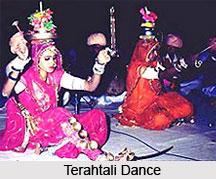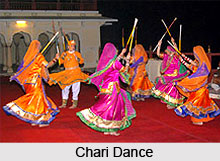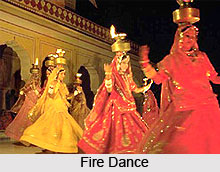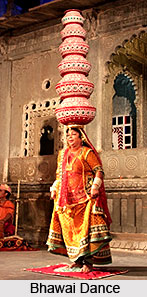Folk dances of Rajasthan are derived from various folk art cultures. They have their own significance and importance. A medieval history includes the existence of princely states, which provided patronage to these art forms and their artists. Vibrant, vigorous and graceful, the dances of Rajasthan evoke the desert in all its moods. The folk dances, found in limitless variations in Rajasthan, punctuate Rajasthan`s barrenness, turning the land into a fertile basin of colour and creativity and are an expression of human emotion as much as the folk music.
Types of Rajasthani Folk Dances
Folk dances of Rajasthan play an important part in its culture. They are not only aesthetically pleasing, but also narrate stories in a unique and captivating way. Each dance is separated from the other by its moves and the custom or festival it is associated with. Following are different types of folk dances of Rajasthan which are popular across the country.
 Gowari Dance
Gowari Dance
The most famous art form of the Bhil tribe is the `Gowari`, which is a kind of dance drama. The performers travel from village to village as a troupe for a month, during which the nine functionaries follow a strict regimen. The entire troupe dances around a central spot concentrated to a deity. A `madal` and a `thali` accompany the performance.
Ghoomer Dance
The Ghoomer dance is a famous community dance of Rajasthan. It is performed on various auspicious occasions by women such as the arrival of a newlywed bride at her marital house, Holi and Teej.
 Terahtali Dance
Terahtali Dance
This fascinating folk dance is also performed by women and is considered as a devotional form of dance. Manjeeras are tied on the wrists, elbows, waists, and arms of the performers. The women with dexterous and fine movements dance at a strong rhythm on beats of `Manjeeras`, whereas, the male partners sing and play on the `Tandoora.`
Drum Dance
It is a professional dance-form of Jalore region of Rajasthan, where only the men participants can perform. In this dance, five men beat huge drums that are tied around their necks and a dancer holding huge cymbals in their hands also accompanies them. For an additional effect, some member holds naked sword in his mouth.
Fire Dance
The stirring fire dance is performed by the `jasnathis` of Bikaner and Churu district. This dance is an example of Jasnathis`s life style. This devotional dance form can be seen only in late nights.
Chari Dance
It is a dance form of the villagers and portrays their happiness when they go in search water and find it. The women go many miles just to collect water to fulfill their daily needs. While going they express their joy through the Chari dance. Dancers while balancing brass pots on their heads perform various steps and dance to gain perfect patterns of movements with their hands.
 Chakri Dance
Chakri Dance
As the name suggests, Chakri means "Chakkar" or rotation in Hindi. Thus Chakri is one of the most popular folk dance of Kanjar tribe where rotation is the main move. It is performed in almost all the marriages and festivals in the Haroti region of Rajasthan. Chakri dance is performed exclusively by the womenfolk of Kanjar tribe.
Kathputli Dance
Kathputli Dance means the dances of puppets. It is a traditional dance of Rajasthan. Through the puppet shows all the real stories of great heroes from village are told.
Kalbeliya Dance
The Kalbeliyas are a snake-charmer community from Rajasthan. They perform the Kalbeliya dance. They rely heavily on this dance performance for their living. It is included in UNESCO`s representative list of the Intangible Cultural Heritage of Humanity from the year 2010
Gair Dance
Gair Dance is a folk dance of the Bhil community of Rajasthan, which is performed at the festival of Holi. There are several differences in the performance of men and women in this dance.
Bhawai Dance
This form is very difficult and can only be performed by skilled artists. Bhawai Dance basically involves women dancers balancing 8 to 9 pitchers on their heads and dancing simultaneously

Kachchhi Ghodi Dance
Originating in the Shekhawati region of Rajasthan, Kachchhi Ghodi is one of the most popular folk genres that depict the stories of the local bandits of the region through dance and music. Traditionally, only men dressed in dhoti-kurta and turban, and riding on an elaborately decorated dummy horse perform this dance.
Chang Dance
The centrepiece of Rajasthan"s Holi festival, Chang is a lively folk dance that originated from the Shekhawati region. Also called as Dhamal, the highlighted characteristic of this dance form is the fast-paced rhythmic beats of the chang instrument.
Khayal Dance
Khayal Dance is performed by the Bhawai caste. The themes are derived greatly from the Hindu epics, Ramayana and Mahabharata. Thought to have been originated from the Jats, this Bhawai caste performs the Khayal dance on heredity basis.
Walar Dance
Walar dance of Rajasthan is a beautiful and enthusiastic tribal dance performed particularly by women. It is an important dance of the Garasia tribe.
Costumes of Rajasthani folk dances
The female dancers wear colourful, embroidered and mirror worked skirts called `ghagra` in most of the performances. They also wear `kurti` or `choli` and `odhna.` The apparel for Rajasthani men are somewhat more restrained than the women`s and are still quite varied in form and texture. Traditionally, the lower garment of Rajasthani men is the unstitched `dhoti` or a stitched garment such as the `pyjama.` Some garments related to the pyjama include the suthan, izar, shalvar or salvor, survala or sural and ghutanna. The upper garment is `bandi` and a `kurta` or tunic that is commonly worn. During some performances they wear `achkan` or `shervani`.
Musical Instruments for Rajasthani folk dances
The Rajasthani folk musicians use sarangi, ghunroos and ektara to bring out sweetest melody. Dhol is the most popular percussion instrument. Nagara is also very popular. Thali and kartal are Rajasthani autophonic instruments. Shahenai and flute are also used for added quotient.
In Rajasthan, folk dances are the outbursts of any celebration and festivity. The Rajasthani people both men and women enjoy dancing. The dance styles reflect their emotion and celebration.



















